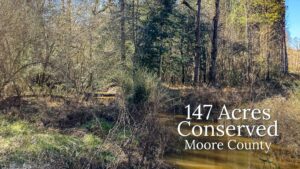
by Ruth Ann Grissom
November 16, 2017

We have an evening routine in the Uwharries. We wait until dark to saunter down the driveway and close the yellow gate. Even on a moonless night, we can usually find our way without flashlights. We tip our faces toward the sky, drinking in the stars, the planets and the Milky Way. In Fall, we also pay attention to the ground. Our path is often illuminated by pulses of light along the driveway.
It’s a taste of an event Mama witnessed years ago. One night, she happened to look out a window facing the small hay field north of the house. She couldn’t believe her eyes. For a moment, she wondered if thousands of tiny aliens had landed on Earth and settled in the grass. She was accustomed to lightning bugs hovering over the field in midsummer, but on that night the land itself seemed electrified.
The source of these mysterious displays is a creature commonly referred to as a glow worm. After a deep dive into the world of fireflies, I learned the term generally refers to a lighting bug in its larval or pupal stage, but it can also be applied to wingless adults such as the female Shadow Ghost (Phausis inaccensa).
One evening, I fell to my knees and plucked a specimen from the short grass along the driveway. The enchanting glow emanated from a brownish, flattened, segmented worm about an inch long. Six tiny legs clustered near a head the size of a pin. I took it inside, put it on a white plate and tried to snap a few photos. It raced around as if panicked by the light, so I quickly returned it to the spot I’d caught it.

In the past, it’s been difficult to find detailed information about glow worms online. Fortunately, Lynn Frierson Faust devotes an entire chapter to them in her recently published book Fireflies, Glow-worms and Lightning Bugs. Faust grew up in the Smoky Mountains, spending summers at a family cabin in Elkmont. Even though she lacks a formal degree in entomology – her background is forensic anthropology – she has become a renowned expert on fireflies of the Eastern US, working with teams of university scientists and serving as a consultant for the Discovery Channel, National Geographic and BBC Nature.
I first contacted Faust during my quest to explain the spectacular lightshow we see in late May in the canopy of our oak and hickory grove. Not only could she identify the species responsible for the display, Photuris tremulans, she’s the person who gave it the wholly appropriate common name “Christmas Lights.”
Based on photos in her book, the glow worm I found appears to be in the genus Photuris. Could it be Christmas Lights or another species I’m not even aware we have? To hazard a guess, I’ll have to wait until next spring and study the flash patterns of the adults.
In the South, fireflies generally remain in the larval stage about a year. In the North – and in trying times of drought or other challenges – it can last up to two years. Larvae seen in the Uwharries in October are likely from eggs laid in early summer. They go through several instars, phases of growth in which they shed their tough outer covering known as the cuticle. After one to three weeks in the pupal stage, they finally emerge as an adult. This is the winged stage familiar to anyone who has ever filled a mayonnaise jars with fireflies. As adults, they live for only a few weeks. They focus on mating, usually to the exclusion of food.
During the larval stage, they are voracious. Most species are terrestrial, subterranean or arboreal. (A few specialists are semi-aquatic.) Even subterranean species surface to forage when the weather is mild in spring and fall. This is when we’re most likely to notice them in their larval stage. To fuel their growth, they seek out energy in the form of worms, snails, slugs and caterpillars.
While adult fireflies flash with the intent of mating, larvae simply glow. Their light might be intriguing to us, but it serves as a warning to predators, of which there are many. Parasites colonize their guts, eating them from the inside out, and they are hunted by assassin bugs, daddy longlegs and spiders. They’re especially vulnerable to the ground-dwelling wolf spider.
While firefly populations can survive these natural predators, adults and larvae alike face serious threats from habitat loss and pesticide application. Thanks to diligent researchers like the incomparable Lynn Faust, we’re learning more about the ecology of fireflies. We now know they might display as adults in one area but hunker down as larvae in another. Protecting both is vital. Hopefully, this understanding will help guide our land management decisions and conservation efforts.
To see a clip from the BBC Nature segment on synchronized fireflies, go to http://www.bbc.com/earth/story/20160224-worlds-largest-gathering-of-synchronised-fireflies
To learn more about Faust and her work in the Smokies, go to https://jezebel.com/summer-in-the-heartsick-mountains-1802178844